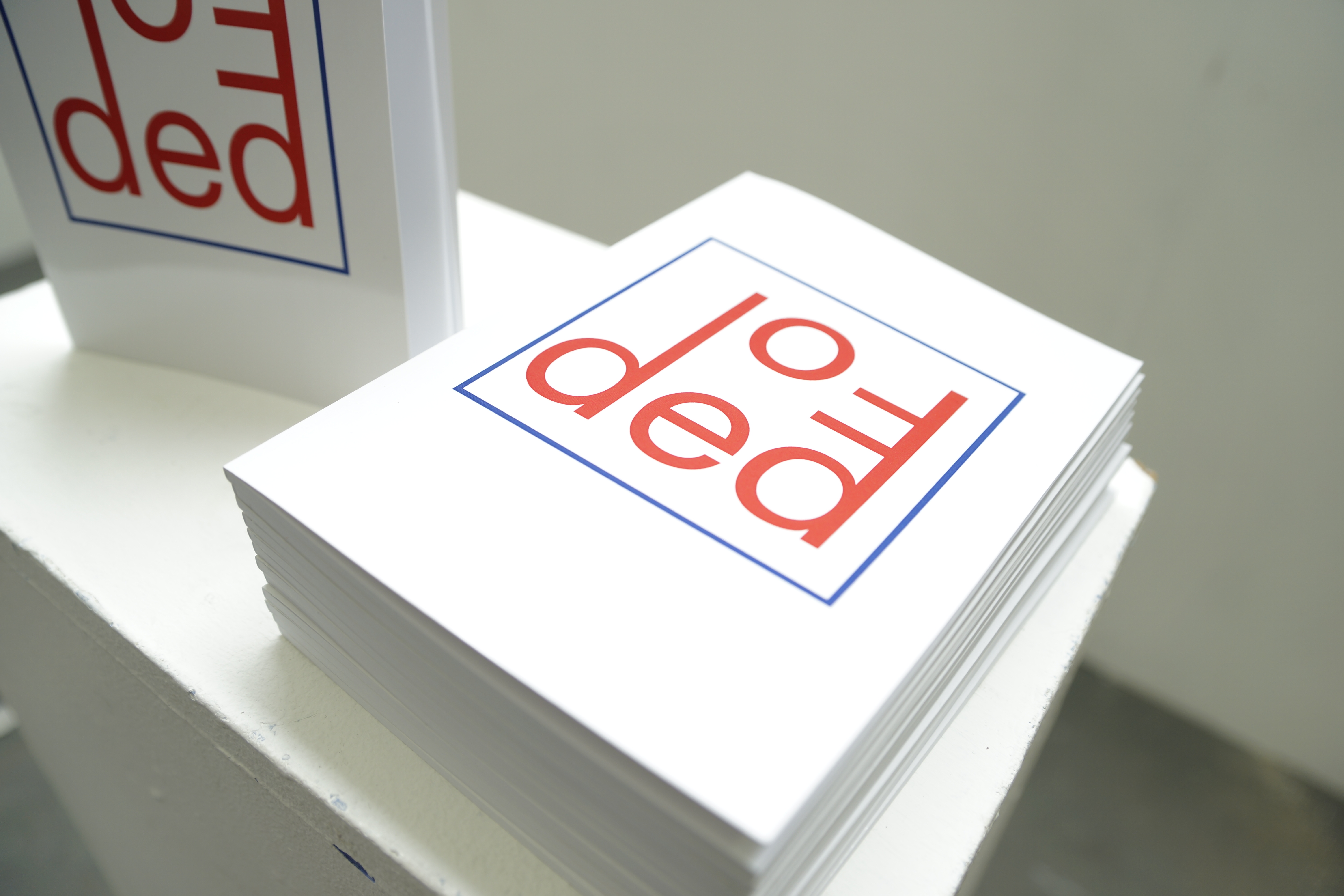Degree Show: Error 404
‘Deciphering the Defined: Fathoming Creativity’
Deciphering the Defined: Fathoming Creativity is a curation of individual and collaborative works by Hazel Lewis-Farley, Eleanor Slaney and myself. All pieces address a different facet of creativity. In Heidegger’s stone metaphor, he describes how, when trying to reach the centre of the stone, ‘it shows us its pieces but never anything inwards… it shows itself only when it remains undisclosed and unexplained’.[1] In this same way we have attempted to dismantle creativity and, whilst concluding that it ‘denies us penetration into it’[2], we have been able to examine the fragments. The film Collecting Creativity is the only shared work in the exhibition. Under two minutes long, it collates and reassembles opinions of creativity and how, as Chris Kraus says, it ‘mean[s] such different things to different people… and how we each weight it’[3]. Centring these conversations are contextualising clips. The film is presented alongside our individual pieces: Inside Out, Outside In (2019, Audio Installation), Grow out of it (2019, Film), Bibliography Unfolding (2019, Paper Installation) and Folded (2019, Book). This collection of work operates similarly to Joseph Kosuth’s One and…[4] series being made up of multiple works exploring the same concept and existing as one investigation.
Having worked collaboratively in previous years, in September 2018 we revisited this partnership and began working as a collective. Initially exploring the process of creating and the dynamics of shared authorship (Work in Progress/Process 2018) then later the emotions involved when creativity and collaboration fails (Goodbye Pyramid 2018), we redirected our focus. Having dealt with our anxieties surrounding art production within university, we intended to question whether a feeling —relaxation/creativity— could be manufactured in an inorganic setting (Relaxation Booth 2019). We have now focused explicitly on the mechanics of creativity, re-establishing ourselves as a collaboration instead of a collective, to reaffirm our own individuality and authorship within our shared investigation. The process of making Collecting Creativity began with us asking members of the public the question: “What is creativity?”. The rest of the conversation was unplanned, subsequently allowing for a natural, unstructured discussion to occur. Reviewing the footage, we edited their answers to showcase the diversity of responses. As the film is displayed on loop with no obvious end, we intend to reiterate that creativity cannot be defined and, therefore, concluded. As a whole, unfragmented, phenomenon its’ “heaviness has escaped us”[5].
My practice investigates the
textual recording of creativity and ‘the relationship between a concept and its
translations… as language’.[6]
Ultimately, I question whether the
methods to capture this phenomenon are adequate. Bibliography Unfolding (2019) and Folded (2019) are works that suggest how by reducing creativity to its
textual depictions, we have lost the allure of its essence. As Heidegger reiterates:
‘we [can] bring its heaviness into the calculable form of weight… [but] If we
try and make it comprehensible by analysing it…it is gone’[7].
Inspired by the curation of Jenny Holzer’s Truisms[8] in the Tate Modern, and Pinot Gallizio’s Industrial Painting[9],
Bibliography Unfolding (2019) is a 30-metre
paper installation that undulates and inhabits its own space within the room.
This fluidity is juxtaposed by the dense uniformity of its’ content. Comprised
of six-thousand references gleaned from the British Library, all entries
mention the phenomenon of creativity within the title. The installation is
intended to function as a visual assembly that highlights how, despite the
array of texts that mention it, creativity rejects confinement. Similarly, Folded (2019) is a portable
encapsulation of creativity. As a book, it is designed to be read and
disseminated with the expectation that the reader, with the textual arsenal of
creativity in their possession, now has the potential to develop this quality.
Because the book has small margins and has no paragraph break, it is
purposefully designed to be impenetrable. Like Fiona Banner’s The Nam[10]
and Rory Macbeth’s Bible (alphabetical
order)[11],
the core of the text cannot be enjoyably interpreted and retained. As each copy
of the book is signed by myself, I call into question the authorship of the
text: in a time where newness seems impossible who does creativity belong to
and, equally, where does true authorship lie? With the library that contains
each book, the authors that are published, or me?
[1] Mitchell, Andrew J. 2010. Heidegger Among The Sculptors. Stanford, Calif.: Stanford University Press, p.11.
[2] Ibid, p.11.
[3] Kraus, Chris. 2018. Social Practices. California: Semiotext(e), P.164.
[4] Kosuth, Joseph. 1965.One and Three Chairs. Wooden Folding Chair, Photograph of a Chair and Dictionary Definition of a Chair. (Also looked at Clock (One and Five), 1965, One and Three Hammers, 1965, and One and Three Plants, 1965.)
[5] Mitchell, Andrew J. 2010. Heidegger Among The Sculptors. Stanford, Calif.: Stanford University Press, p.11.
[6] Snauwaert, Dirk. “Marcel Broodthaers, Musée D’Art Moderne, Départment Des Aigles, Section des Figures.” Mousse Magazine, 2015.
[7] Mitchell, Andrew J. 2010. Heidegger Among The Sculptors. Stanford, Calif.: Stanford University Press, p.11.
[8]Holzer, Jenny. 8 Truisms. 1977-1979. Courtesy of Sprüth Magers Gallery on short term loan, Tate Modern.
[9]Gallizio, Pinot. Industrial Painting. 1958. Tate.
[10] Banner, Fiona. The Nam. 1997. In FionaBanner.com. Accessed April 30, 2019. http://www.fionabanner.com/vanitypress/thenamsb/index.htm?i07..
[11] Bible (alphabetical Order). 1997. In Post-Digital Publishing Archive. November 13, 2015. Accessed April 30, 2019. http://p-dpa.net/alphabetizing-the-bible-a-chronology/
















